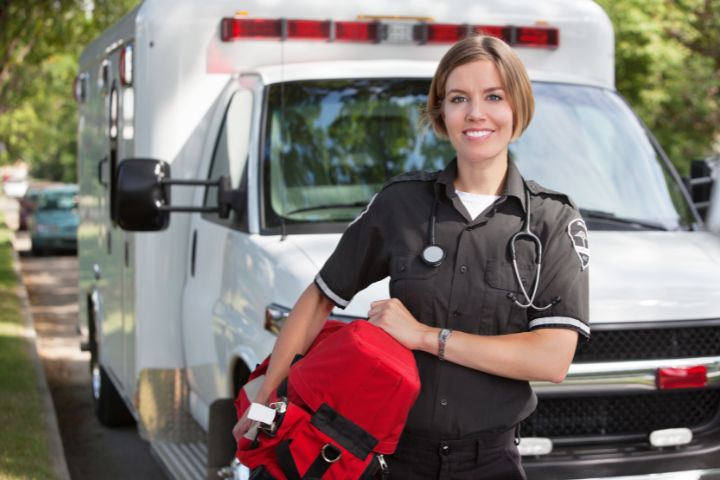As an EMT, your day is all about being active, this career is not an office desk job; being flexible and constantly on the move is a must! EMTs are medical professionals that provide emergency medical services to those in need in their communities. EMTs are frequently found working for ambulance companies, responding in cases of emergency health related situations.
You will need both soft and technical skills to be successful. You can obtain technical EMT skills through a training program. However there are soft skills considered a must for this profession as well. Soft skills such as being able to communicate effectively in high pressure situations and being attuned to detail are required, due to the nature of an EMT’s job. Continue reading to learn more about some of the skills required!
Explore the Dorsey College EMT Program!
Soft EMT Skills:
Soft skills focus on attributes of an individual that enable a person to be proficient in their field alone and while working with others. EMT soft skills are necessary for interaction, listening, problem-solving, and management of healthcare.
Examples of EMT Soft Skills are:
- Communication skills
- Organization skills
- Physical fitness
- Professional behavior
- Compassion
Communication:
Communication is vital when a life is on the line, and an emergency occurs! Emergency Medical Technicians must be effective in communication. Listening is also essential. An EMT is responsible for direct contact with a patient under medical care on the scene of an emergency.
EMTs must establish an immediate rapport and begin collecting information to transfer to the hospital staff. Accurate assessments depend on clear, concise communication with all medical professionals. EMT teams with solid communication are often successful in handling emergencies properly and transitioning patients effectively once they reach the hospital.
Organizational Skills:
An EMT workplace often has many moving parts because these healthcare professionals are always on the go! Recording patient symptoms, health history, and more while in a moving vehicle seriously takes skills! Organizational skills are needed for an EMT to perform their job effectively and efficiently. For example, knowing where the equipment you need in a crisis situation can save lives! Organization is a skill you can practice and get better with time and training.
Physical Fitness:
Being an EMT requires a certain amount of physical fitness. You will be constantly moving and required to do a fair amount of lifting and maneuvering.
Generally, EMTs must be able to:
- Get in and out of an ambulance
- Move equipment fast and efficiently
- Lift patients
- Load patients on an ambulance
- And more!
Professional Behavior:
Professional behavior focuses on how an employee carries themselves. EMTs should be reliable. This includes arriving on time to work, especially in emergencies. Be optimistic and polite; patients and team members rely on you to hold it together! An EMT should also be trustworthy. If you are given tasks, be accountable. EMTs give back to their communities and should be professional at all times.
Technical EMT Skills:
Technical EMT skills focus on the hard skills an emergency medical technician must have. EMTs must go through extensive medical training to master common duties and responsibilities.
Some Technical EMT skills are:
- Providing basic life support
- Conducting patient assessment
- Transporting patients to the hospital
- Splinting and immobilization
- And more!
Basic Life Support:
Basic life support consists of stabilizing a person in need experiencing a life-threatening event. An EMT must have the technical skill to work with supplemental life support machines such as an AED or external defibrillator. EMT school courses teach aspiring EMTs how to perform CPR and chest compression and how to work these machines to help increase patient ventilation levels.
Patient Assessment:
An emergency medical technician must know how to make patient assessments. Patient assessments assist medical providers in obtaining pertinent information to make accurate treatment decisions for each patient and not overlook any vital data while at work. EMTs must know how to handle emergency calls and determine scene safety. EMTs must be observant, noting valuable data and the nature of illness in a patient, and decide what resources should be used until the patient reaches the hospital. In a program you can learn how to assess a patient through proper training from expert professionals.
Transporting Patients to the Hospital:
EMTs (and Paramedics) are responsible for providing pre-hospital care. As a result, they are responsible for responding to a scene, providing necessary care to patients on the scene, and then safely transporting them to the hospital (or another healthcare facility) where they can receive additional treatment.
Splinting and Immobilization:
While transporting patients, EMTs must ensure the patient is comfortable and safe. When transporting patients, no body parts shall be dangling. If a patient is immobilized, padding and splinting must be placed accurately. Once support is given, it can relieve patients from pain due to a lack of support for fractures. Splinting assists with the reduction of further damage of soft tissue injury from bone movement while decreasing patient pain. How to properly handle immobilization can be learned in an emergency medical technician school.
Learn these EMT skills and more in a training program!
Dorsey College is dedicated to helping prepare aspiring EMTs to obtain the skills needed to succeed in a healthcare career.
Aspiring EMTs are required to complete these clinical hour requirements to achieve EMT-Basic certification (in addition to completing their program requirements and the requirements set forth by the state):
- 32 hours of clinical experience
- 24 ambulance-hours
- 8 emergency room-hours
To help you hone these skills, Dorsey College’s expert staff will help students from beginning to end in your EMT training journey. Contact Dorsey College today to get started!
Dorsey College has determined that its Emergency Medical Technician training program curriculum is sufficient to fulfill educational requirements for licensure in the State of Michigan only. No educational determinations have been made for any other state, district, or US territory in regards to licensure requirements.

